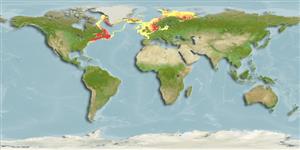Classification / Names
Common names from other countries
Main reference
Size / Weight / Age
Max length : 150 cm TL male/unsexed; (Ref. 7251); max. published weight: 23.6 kg (Ref. 40637)
Length at first maturity
Lm ?, range 50 - 60 cm
Environment
Marine; demersal; oceanodromous (Ref. 51243); depth range 1 - 600 m (Ref. 58426), usually 18 - 110 m (Ref. 7135)
Climate / Range
Temperate, preferred 9°C (Ref. 107945); 79°N - 37°N, 75°W - 56°E (Ref. 54281)
Distribution
Northeast Atlantic: Spitsbergen southward to White Sea, Scandinavian coasts, North Sea, the British Isles, also Iceland and south-eastern coasts of Greenland. Northwest Atlantic: southern Labrador in Canada and western Greenland to Cape Cod in Massachusetts, USA; rarely to New Jersey, USA (Ref. 7251). Elsewhere in the Baltic Sea (east to Rügen and Bornholm Islands), Bay of Biscay and northwestern Mediterranean (Gulf of Genoa) (Ref. 57932).
Countries | FAO areas | Ecosystems | Occurrences | Introductions
Short description
Ground color usually greyish-green but almost black or reddish -brown. Body with 10-15 transverse, dark bars extended to the dorsal fin (Ref. 35388).
IUCN Red List Status (Ref. 115185)
Threat to humans
Harmless
Human uses
Fisheries: highly commercial; aquaculture: experimental; gamefish: yes; aquarium: public aquariums
More information
ReferencesAquacultureAquaculture profileStrainsGeneticsAllele frequenciesHeritabilityDiseasesProcessingMass conversion
Tools
Special reports
Download XML
Internet sources
Estimates of some properties based on models
Phylogenetic diversity index
PD50 = 0.5938 many relatives (e.g. carps) 0.5 - 2.0 few relatives (e.g. lungfishes)
Trophic Level
3.6 ±0.0 se; Based on diet studies.
Resilience
Low, minimum population doubling time 4.5 - 14 years (K=0.04-0.1; tm=6-7; Fec=12,740-25,000)
Vulnerability
High to very high vulnerability (67 of 100)
Price category
